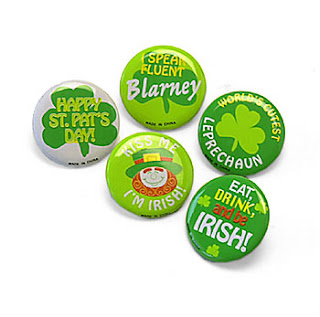The Irish people really love their traditions and are incredibly proud of them. Most of the traditions have remained truly Irish but there are some traditions that have become globally celebrated, like the wearing of something green on St. Patrick’s Day.
To explore a few of their traditions, let’s first look at the St. Patrick’s Day celebrations in Ireland. The wearing of green clothes actually started in countries outside of Ireland when the Irish overseas wanted to show that they were Irish. The wearing of the colour green slowly spread around the world, and now, even though it is not customary, many Irish people wear green as well. The Irish do, however, pin a shamrock to their clothes. This is supposed to be a symbol of the holy trinity, the teachings of St. Patrick.
Till the 70’s, pubs were not allowed to stay open on St. Patrick’s Day so the drinking of green beer, is also something that originated overseas, probably in the U.S or Canada. In Ireland, after church, most families return home for a feast and then to watch the St. Patrick’s Day parade on television. The parade was actually started overseas too, and only much later did the Irish government start the parade in Dublin just for its tourist value.
It is quite clear that the Irish people have adopted a lot of the St. Patrick’s Day celebration traditions from other countries, just to boost the hype around what is supposed to be a religious holiday. The tradition of celebrating St. Patrick’s Day has clearly been diluted as a product of Globalization, which, essentially, is partially responsible for the spread of Irish people all over the world. While this looks bad for Irish culture, it does, for at least one day a year, give the Irish people globally a chance to showcase their national pride and brings Irish culture to light in these countries when Irish music is blasted from pubs and the culture and dance of the Irish being the main focus of the parades.
One of the traditions that have remained truly Irish, and possibly one of my favourite holidays, would be Nollaig na mBan, or as it is more commonly known, Little Women’s Christmas or Little Christmas. This is celebrated on the 6th of January, and it is traditionally the day when women get the day off all household duties. This started because men in Ireland never really helped out around the house because it was not expected of them as it was considered a woman’s job. If men did any housework, they would have been ridiculed by their friends. It was decided that the women needed at least one day off a year and so Little Christmas came about.
Gender inequality is not that large an issue today in Ireland so it would seem like this tradition should have faded out but in parts of Ireland, like Kerry, it is still celebrated by most women. They gather in pubs all over Ireland to enjoy their stout and corned-beef sandwiches together and celebrate their day off.
The last set of traditions we’ll look at in this post is the Irish’s Easter traditions. Easter is an incredibly important day for many Irish people considering that the majority are Catholic. Part of their Easter customs are similar to those celebrated by Christians all over the world. This includes fasting from something they treasure like meat, alcohol or cigarettes. Some of their rituals are rather strange though. Below is a summary of some of the things that they do over the Easter weekend, starting from Good Friday, from the website http://irelandfun.wordpress.com/
On Good Friday:
- A complete “spring cleaning” of the home.
- Doing no work with tools, in order to avoid spilling any blood from an accident.
- Mark one of the eggs laid on the farm on Good Friday to be eaten with the celebration meal on Sunday.
- If you die on this Good Friday, you go directly to heaven.
- Gather food on the shore, but do not go out fishing in a boat.
On Easter Saturday:
- Go to church and drink a few sips of holy water, then sprinkle a bit on the family and even the farm animals for good luck.
- Turn off all lights in church at 11 pm and light a Paschal Candle as a symbol of Christ rising from the tomb.
On Easter Sunday:
- Get up at sunrise and do a celebration dance.
- A mock funeral is conducted by the town butchers with a dead herring. The poor fish is a symbol of the end of Lent, when some Irish folk once ate lots of herring, because it was the only available alternative to meat.
- Gather for a contest called a “cake dance,” where the winner gets the cake
To conclude this post, we can see by looking through these traditions how tourism and even globalisation has begun to affect traditions of a place, like in the case of St. Patrick’s Day. What I find surprising though is that some of the traditions in Ireland have remained untouched. My guess would be that this is because these traditions never really picked up in the countries that the Irish immigrated to and, therefore, failed to become seen as a major symbol of Ireland. Personally, I think it is nice that the Irish have managed to retain some of their original traditions while still having some that have been commercialized and now act as a platform for people to appreciate their culture.
Coming up in the next post, the languages of Ireland and their mode of education.
In this post, I have used the following sites for references for my information.
The Image credits go to :
















